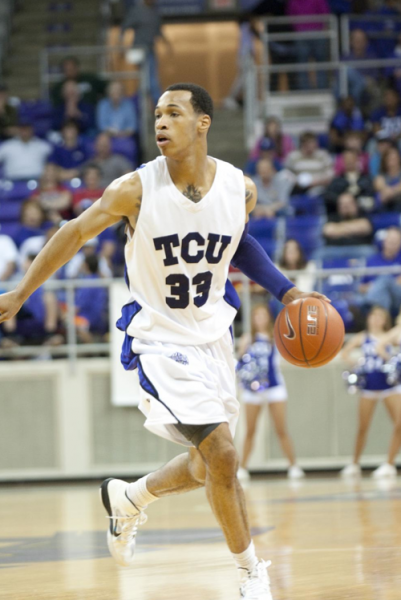Big 12 Team Preview #10: TCU Horned Frogs
Posted by dnspewak on October 29th, 2012Each day for the next two weeks, we’ll bring you the obligatory team preview here at the Big 12 microsite. First up, Danny Spewak (@dspewak) breaks down the league’s newbie: TCU. The Horned Frogs were not a unanimous choice among the Big 12 microsite writers to finish last in the conference, but we’re guessing we still won’t find much argument with this selection.
The Skinny
- 2011-12 record: 18-15 overall, 7-7 Mountain West
- Key Contributors Lost: G Hank Thorns, G J.R. Cadot, F Craig Williams
- Head Coach: Trent Johnson, 1st season
- Projected Finish: 10th
Trent Johnson has problems. The team he inherits in Fort Worth finished in the lower third of Division I basketball in almost every defensive statistical category in 2011-12. He has no proven scorers, no proven shooters and only a handful of experienced upperclassmen. It will not be an easy season for the TCU Horned Frogs, but that has nothing to do with the change in conference affiliation or the mystical power of the Big 12. This squad played in a league with four NCAA Tournament teams a year ago, and it knocked off three of those teams — Colorado State, New Mexico and UNLV — on its home floor. The Horned Frogs won on a neutral floor against Virginia in November, defeated Texas Tech at home (hey, it’s a Big 12 school at least), and played a total of five power conference teams before entering Mountain West play. And remember, that league actually finished above the ACC in conference RPI rankings and sat just two slots below the Big 12. The sudden move to the Big 12 will not cause a mass panic among TCU’s players. They’ve seen good players and good teams before. They’ve played at The Pit and in front of hostile crowds. The problem is not the Big 12 — the problem is simply Trent Johnson’s lack of overall play-makers and proven leaders. He made a splash earlier this month by outbidding Bill Self, Scott Drew and Rick Barnes for Class of 2013 prep center Karviar Shepherd, but that’s the future. Before Johnson can channel the success he enjoyed at Nevada, Stanford and during the early part of his tenure at LSU, he’ll need to build this program very slowly.
The Personnel
Point guard Kyan Anderson and wing Garlon Green are the keys to this team, and we even have the statistics to prove it. In TCU’s three banner victories at home against Colorado State , UNLV and New Mexico a year ago, Anderson dished out 6.3 assists per game against an average of only two turnovers. That’s a stunning statistic for a guy who barely finished with an assist to turnover ratio of 1:1 in 2011-12, but it’s proof that his ability to distribute will serve as this team’s engine this season. Meanwhile, in those same three contests, Green scored in double figures each time, even though he did not start against either UNLV or New Mexico. With the graduation of leading scorers J.R. Cadot and Hank Thorns, it’s up to Anderson and Green to serve as the engines of this new-look roster. As we outlined above — in a very small sample size, of course — these are the two most valuable players on this team and the only two guys with the ability to emerge as potential stars and leaders of this program. Overall, both played very encouragingly throughout the 2011-12 season. Anderson may not have developed as a consistent scoring option, but the Mountain West Freshman of the Year earned a starting role in December and never relinquished it. Green showed the occasional scoring pop as he slid in and out of the starting lineup, but he’ll now take on a greater role as a senior. He’s an above-the-rim kind of player who can present match-up problems on the wing with his athleticism, and if he shoots like he did as a sophomore (48 percent from three), there’s no telling what kind of season he could have.
Green is the team’s leading returning scorer at 9.9 points per game, and Anderson is the leading assists man at 2.8 per game. Hardly gaudy statistics, but Johnson will rely on them for production. He’ll also rely on Arkansas transfer Devonta Abron, who will play right away after the NCAA granted him eligibility. He’s an unknown commodity as a scorer after a modest freshman season in the SEC, but even if he doesn’t score a point, though, he’ll be an invaluable source of toughness and rebounding. Abron brings a mentality and culture of brashness TCU did not have a season ago, and he also rebounds the ball with authority and rather unbelievably averaged 4.2 rebounds in about 16 minutes per game of action. Give this guy 30 minutes a game, and he might make an all-conference team. Abron has help in the frontcourt, too, thanks to a trio of forwards who seem like exact molds of each other in terms of playing time: Connell Crossland, Amric Fields and Adrick McKinney. Fields and Crossland are a little on the thinner side, whereas McKinney uses his 250-pound frame to play more physically in the post, but they all averaged between 11 and 21 minutes per game in 2011-12. Along with freshman center Aaron Durley, a former Marquette commitment who also once took the Little League World Series by storm, Johnson has a ton of options to lean on in the frontcourt. Remember, too, that Fields was the Mountain West Sixth Man of the Year last season. Of the aforementioned players, he might be the guy to keep an eye on as a real scoring threat down the road.
Unfortunately, that frontcourt depth looks a little more solid than TCU’s guard play. Anderson has proven he can play, but Nate Butler Lind is the only other returning guard on this team with much experience at this level. He lost his starting spot in mid-December, and he’ll now fight with a few interesting veterans for playing time. Brown transfer Christian Gore and junior Jarvis Ray, who sat out much of 2011-12 with academic issues, could be in line for more playing time. Freshmen Charles Hill and Clyde Smith won’t need to play like stars right away, but both offer specific skill sets that could prove valuable on this team. First of all, they’re both combo guards who can play a variety of positions. Hill makes his mark on the defensive end, whereas Smith is more of a scorer with a renowned shooting touch from mid-range and beyond the arc.
Turkish freshman Kemal Dincer, former student manager Chris Zurcher and deep reserve Thomas Montigel round out Johnson’s first roster at TCU.
Why They Might Be Better Than You Think
It may not seem like much on the surface, but Trent Johnson has a decent core of players with which to work. At this point, it’s all about consistency and growth. Anderson and Green played like studs at times in 2011-12. If they keep improving with an additional opportunity for playing time, maybe we’re talking about a couple of third-team all-Big 12 kind of players. And if Abron’s as good of a rebounder as he showed in limited playing time as a freshman, maybe he’ll emerge as one of the conference’s better glue-guys in the post. Maybe Aaron Durley is polished enough to contribute as a frosh; maybe the frontcourt depth will develop; maybe the freshman guards are even better than advertised. It’s also easy to forget that before a somewhat difficult tenure at LSU, Trent Johnson was considered one of the game’s rising coaching stars after his stops at Nevada and Stanford. No, he doesn’t have the Lopez twins on this roster. Still, with nothing to lose and no expectations, there’s no reason the Horned Frogs can’t repeat their performance from 2011-12, when they played the role of spoiler in the Mountain West and made life miserable for the league’s top teams.
Potential Roadblocks
Defensively, this team must improve. Otherwise, there’s no chance it finishes better than ninth in the Big 12. A year ago, TCU ranked 286th in scoring defense and 264th in defensive efficiency. That’s atrocious. It turned the ball over too much on the offensive end, too, and there are so many question marks with Anderson’s consistency at the point guard position. He’s a promising player and only a sophomore, but he’s never turned in a fully consistent season at the Division I level. Green has never been The Guy for his team, nor has Abron. Add it all up, and here’s a team that must replace its two leading scorers, completely change its identity on defense and develop a cast of newcomers who may or may not be ready to contribute at this level right now. It’s a tall task, but Johnson knew that when he took the job.
The Sleeper Candidate
Johnson is lucky he inked freshman Aaron Durley, who spurned Marquette last spring and pledged to TCU in May. He’s now the only true center on the roster and an important signing for Johnson’s program, since he hails from nearby Houston. Durley’s game needs work, but he’s considered a fairly polished big man who can move pretty well for his size. He’s also a fascinating story after his performance in the Little League World Series in 2005. Back then, he was already 6’9”, setting a record as the tallest player to ever compete in the event. He won’t have that kind of size advantage on fellow Big 12 forwards, but Durley has a promising future in this conference if he continues to add to his frame and use his athleticism to his advantage.
Final Projection
You’re looking at a cellar-dwellar here. Abron’s immediate eligibility helps, but Johnson would need some sort of magical turnaround to finish anywhere near .500 in league play in 2012-13. It’s impossible to (pardon the cliche) “build a winning culture” in just one season, but TCU needs more than just a winning culture. It needs to drastically change the way it approaches the defensive end. It needs a sophomore point guard to lead the way and it needs unproven forwards to grow into primary scorers. Perhaps it’ll all materialize and we’ll look like fools at the end of the season. Stranger things have certainly happened in sports, and hey — it’d be quite a story.











































